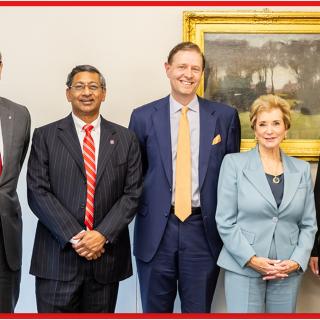On June 7, 2025, CNN will broadcast—on tape, from a live performance direct from Broadway--George Clooney’s homage to Edward R. Murrow, Good Night, and Good Luck, which is welcome news for audiences who are not able, or willing, to fork over the $900 plus fees for a decent orchestra seat to the stage version of Clooney’s 2005 docu-drama Good Night, and Good Luck.
For American progressives wallowing in a deep Trump funk, the callback to the integrity of Murrow and his gutsy take-down of Sen. Joseph McCarthy on the pioneering news magazine See It Now may offer hope that journalism can repeat its treasured origin story. The legend is imprinted in the famous illustration by Ben Shahn, Edward R. Murrow Slaying the Dragon of McCarthy, a depiction of the noble paladin killing the beast who threatened the realm. In the Clooney iteration, no one needs a playbill to read McCarthy as a stand-in for Donald Trump, but Murrow has no obvious successor ready to suit up in the new media ecosystem. Morrow and his like have gone the way of vacuum tubes and rabbit ears.
Even before Murrow’s death in 1965 (from emphysema: he was a four pack a day man), he was hailed as the gold standard for broadcast journalism, a reputation that only grew over the years. In The Powers That Be, his 1979 study of the MSM of the day, the cultural historian David Halberstam was startled by how often Murrow’s name still came up CBS newsrooms whenever a question of journalistic ethics was on the table. In Michael Mann’s The Insider (1999), a drama about the crisis of conscience at 60 Minutes when the show was under pressure to spike a story by a tobacco company and CBS’s own corporate lawyers, correspondent Mike Wallace, played by Christopher Plummer, wails, “They’re accusing me of betraying the legacy of Edward R. Murrow!” For a broadcast journalist, there can be no greater insult.
The reverence is understandable: his career arc traced and came to define the golden age of broadcast journalism, first in radio, then in television. Born in 1908, a graduate of Washington State College, he worked as an educator before joining CBS radio in 1935. He was sent to London in 1937 and tasked with the creation of a series of foreign bureaus in Europe that would be for radio what the AP and UP were for newspapers. Advances in shortwave broadcasting technology had recently made it possible to beam news from overseas—live, as it happened--into American living rooms, and the news was momentous and terrifying. Murrow was the best of a new breed of radio newsmen who didn’t just read newspaper headlines but who explained and gave context to the bewildering cascade of geopolitical events. By 1938, either Murrow or one of his protegees (“Murrow’s Boys”—no girls) were on site to cover the march of Nazi Germany into Austria, Czechoslovakia, Poland, etc. In 1940, from London during the Nazi blitz, Murrow broadcast live from the roof of CBS headquarters as air raid sirens blared in the background. (“This”-- dramatic pause—“is London.”) During World War II, he accompanied bomber crews on B-17 missions over Germany and followed Allied troops into Paris. He was there at the end too, at Buchenwald, struggling to render in words the sights—and smells—for his most extraordinary radio broadcast on April 15, 1945, “If I’ve offended you with this rather mild account of Buchenwald,” he told his listeners as he wrapped up the report, “I am not in the least sorry.”
The postwar years were good to Murrow. The handsome radio star made a seamless transition into television: his radio show Hear It Now become See It Now. “It’s a cinch that [Murrow’s] the No. 1 candidate for TV’s glamour boy in the realm of commentators-newscasters-analysists,” said Variety in 1951, coining a new word for his small screen charisma: telegenic. In an early episode of See It Now, telecast on February 24, 1952, he reported on a Chinese American veteran who was denied permission to buy a house in an all-white neighborhood. He ended the report with a live picture of the Statue of Liberty and a reading of the Emma Lazarus poem at its base.
Postwar television was also good to the anti-communist crusader Sen. Joseph McCarthy, who rode the medium-- and the fears of Cold War Americans--to outsized prominence. By 1953, newly empowered with a senate chairmanship, he and his ism were the dominant force in domestic politics. (The term “McCarthyism” was coined on March 29, 1950 by Washington Post cartoonist Herbert Block, who drew a tower of tar buckets with the topmost bucket labelled “McCarthyism.”)
It was perhaps inevitable that the embodiment of civility and the defender of civil rights would clash with his opposite. Cautiously at first, Murrow used his forum on See It Now to push back against McCarthy’s assaults on due process and free expression, not mentioning the senator by name but attacking the ism. He and producer Fred Friendly mounted a series of shows whose true target was obvious to savvy viewers: an exposé of the U.S. Air Force for unjustly denying a security clearance to a meteorologist named Milo Radulovich (October 20, 1953); a laudatory profile of Gen. George Marshall, whom McCarthy in 1951 had notoriously accused of treason (November 3, 1953); and a report on the efforts of the ACLU to find a meeting place in Indianapolis (November 24, 1953). Not incidentally, most of the episodes of See It Now survive on kinescope, the 16mm film format that preserved live television shows before the introduction of videotape in 1956. The shows may be viewed either on YouTube or at the William S. Paley Center for Media in New York, a big reason Murrow’s work remains so alive in media memory.
On March 9, 1954, Murrow was ready to name the name on the landmark See It Now episode, “A Report on Senator Joseph R. McCarthy,” whose production and telecast provide the source material for Good Night, and Good Luck, stage and screen. It was not the first media broadside at McCarthy, but it was the first meaningful criticism on television, by then the nation’s most important media platform.
Throughout the thirty-minute program, Murrow and Friendly’s tactic was to let McCarthy hang himself by editing together film clips that showed him at his worst: vulgar, reckless, and deceitful. Murrow’s concluding monologue—delivered live as he reads from a transcript at his desk, looking up at the screen at crucial beats-- plays like a Shakespearean soliloquy in cadence, eloquence, and moral force. “We are not descended from fearful men,” he reminds his viewers. If the American experiment were to fail, the fault would be “not in our stars but in ourselves.”
Despite Murrow’s prestige, the attack on McCarthy was a risky gambit. He knew McCarthy would assail his patriotism and demand equal time from CBS to respond (he did, and CBS gave him airtime on See It Now itself on April 6, 1954). Murrow was less certain about how the show would play with the American public. See it Now’s director Don Hewitt, later founding producer of 60 Minutes, recalled that after the telecast, Friendly, Murrow, and he walked over to Sardi’s for a late dinner. When the diners looked up and saw Murrow, they all put down their silverware and applauded. “We knew then we’d be okay,” he said.
Two days after Murrow’s broadcast, the U.S. Army released an incriminating chronology of telephone calls made by Roy Cohn, McCarthy’s chief counsel, to Secretary of the Army Robert T. Stevens. The chronology documented Cohn’s attempts to browbeat Stevens into granting special privileges to G. David Schine, a former member of McCarthy’s staff, a close friend to Cohn, and currently a private in the U.S. Army. The resulting series of charges and counter charges led to the Army-McCarthy hearings, telecast live on ABC (not CBS) from April 22 to June 17, 1954. It was the fallout from the hearings, not Murrow’s report, that led ultimately to McCarthy’s condemnation by the U.S. Senate. He died in 1957, still taking, but nobody listening.
Of course, the ism has had a longer shelf life, both as noun and practice. Good Night, and Good Luck closes with a montage of ominous video screen images of McCarthy’s presumed inheritors capped with a picture of Elon Musk with upraised arm.
There’s a word for that.
--------------------------------------
Thomas Doherty is a professor of American studies at Brandeis University. He is the author of Cold War, Cool Medium: Television, McCarthyism, and American Culture, published by Columbia University Press in 2003.



